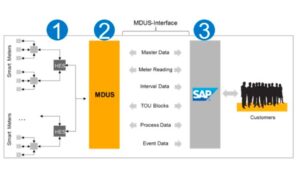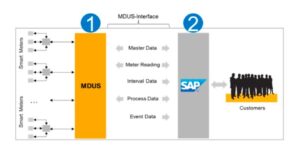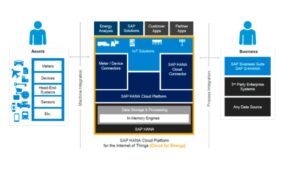Energy demands across the globe have been steadily increasing and continue to rise over time. Whether it is crypto mining, increased demands for work from home, or combatting summer heat, one thing is constant: energy demands fluctuate. However, we can provide customers with preferences and analytics about their energy usage from SAP.
In an increasingly data-driven and consumer-customized atmosphere, today’s Utility providers focus on a few essential areas:
- Firstly, continuous improvements to customer service to reflect customer demand.
- Combating peak energy demands to overcome nearing maximum usage of energy generation, thus reducing the loads required to serve the customer base.
- Finally, choices for on-peak adjustments and sustainably-sourced energy.
Our customers want a centralized view of their usage and the ability to choose their energy experience. Advanced Metering Infrastructure (AMI) or Smart Meters enables real-time data collection for Utility usage. Subsequently, it plays a critical role in addressing these challenges.
Background on Advanced Metering Infrastructure (AMI)
Smart meters provide consumers with near real-time information on their usage patterns, allowing them to manage their energy use.
Such information gives customers the control to make changes that will help them save money and reduce emissions. However, smart meters also remove the need for someone to visit your house to read the meter. Lastly, it brings an end to estimated billing.
For the energy providers, real-time communication and data collection help them better understand the needs of their customers and offer more competitive products in a timely fashion.
Predicting Usage to Drive behavior
Many Utility providers are managing the challenges of increasing consumer demand coupled with an overtaxed grid. To avoid energy generation capacity limits and potential rolling blackouts, many organizations have developed programs to encourage their customers to consume more of their energy during off-peak hours.
Success requires:
– A thorough analysis of when demand spikes occur.
– A method to set pricing as an incentive for off-peak usage
– The means to communicate this information to consumers
All of the above are possible with AMI and smart meters.
The Benefits of AMI
AMI can benefit Energy providers through:
- Firstly, reduced billing exceptions – Eliminates the manual read process and increased meter accuracy with automated reads.
- Increased operational efficiency – Reduces overhead costs on manual read collection and operational work at service connections and disconnections.
- Improved customer service – Provides customers with access to usage data on their daily consumption, demand, and other metrics to inform customers to help them minimize their usage.
- Offers customers real-time information about utility outages and restoration.
- Improved operational capabilities – supports remote disconnect/connect, advanced outage reporting, detects power quality and energy theft, and tampering safety concerns.
- Finally, a roadmap for future initiatives – provides the foundation for smart grid management to facilitate the integration of distributed generation, automation, and energy conservation for voltage reduction.
Core capabilities delivered by AMI solution:
- Automated remote read collection for electric, gas, and water meters
- Support remote billing for residential and commercial customers
- Controlled remote disconnect to support dunning disconnect and customer moves
- Controlled remote reconnect to support customer move-in.
- Real-time payment integration to support immediate automated reconnection
- Monitor and manage meter events near real-time and automate fieldwork
- Automate on-demand meter status and reads to support customer inquiries
- Provide seamless integration to view daily usage data from MDM
- Enhanced customer service with access to usage data and remote connect/disconnect
Building Blocks of Advanced Metering Infrastructure
AMI includes various hardware and software components. All of which play a role in measuring energy consumption and transmitting information about energy, water, and gas usage to utility companies and customers. The overarching technological components of AMI include:
- Firstly, Smart Meters– Advanced meter devices have the capacity to collect information about energy, water, and gas usage at various intervals and transmit the data through fixed communication networks to utility, as well as receiving information like pricing signals from utility and conveying it to the consumer.
- Secondly, Communication Network: Advanced communication networks which support two-way communication enable information from smart meters to utility companies and vice-versa. However, networks such as Broadband over PowerLine (BPL), Power Line Communications, Fiber Optic Communication, Fixed Radio Frequency, or public networks (e.g., landline, cellular, paging) are primary mediums for such purposes.
- Meter Data Acquisition System– Software applications on the Control Center hardware and the DCUs (Data Concentrator Units) used to acquire data from meters via the communication network and send it to the MDMS
- Finally, Meter Data Management System (MDMS): Host system which receives, stores, and analyzes the metering information.
Examples of communication technologies:
| Wired | Wireless |
| Fiber optic cable radio | Radio Frequency (RF) – mesh network power power power power |
| Power-line communications (PLC) | RF – Point to multipoint telephony telephone telephone telephone |
| Telephone dial-up modem | RF – Cellular |
| Digital subscriber line (DSL) |
Choosing the most appropriate communication technologies and configurations required utilities to examine multiple requirements, considering all smart technologies that may use the networks: Bandwidth, Latency, Cost, Reliability and coverage, Spectrum availability5, Backup power needs, Cybersecurity consideration.
How can energy providers implement Advanced Metering Infrastructure with SAP?
Architecture:
- Firstly, Smart meters installed at the customer’s premises that collect their electricity consumption data. This is done in in 5-, 15-, 30, or 60-minute intervals.
- Secondly, new or upgraded communications networks to transmit the large volume of interval load data from the meter to the utility back offices.
- Finally, a meter data management system (MDMS) stores and processes the interval load data. It integrates meter data with one or more essential information and control systems. These can include head-end systems. It can also include billing systems, customer information systems (CIS), geographic information systems (GIS), and outage management systems (OMS). Additionally, it can include distribution management systems (DMS). (Not all utilities use an MDMS.)
Three-tier architecture typically consists of three key components:

Two-tier architecture
Firstly, a 2-tier architecture connects SAP directly to the Head-End system. Additionally, this follows an MDUS approach, leveraging the same enterprise services. However, the significant change is that SAP EDM becomes the source of truth for the meter data.

Cloud for Energy
SAP has developed a new Cloud for an Energy solution based on the SAP Cloud Platform. As well as native integration back to SAP S/4HANA (including IS-U) it will feature APIs for integration to Head End Systems as well as meters, sensors, and other components based on the CIM standard (IEC 61968-9). Subsequently, this IoT data model means it can collect data directly from the assets.

Components of ISU affected with Smart Metering & AMI solution:
DM – new meter creation process with AMI capabilities, Meter Install, and replace and remove scenarios. Estimated meter reads no longer required.
- Create/Change Device (IQ01/IQ02 and IQ04)
- Full Replacement (EG30)
- Full Installation (EG31)
- Technical Installation (EG33)
- Billing-Related Installation (EG34) [this transaction can only be used if a device information record was created using this transaction]
- Device Modification (EG42)
- Create Device Information Record (EG44)
Billing – After AMI, bill print and billing with interval data
Customer Service (CRM) – Agents must be trained to handle customer inquiries and complaints.
Real-time meter status check.
AMI event monitoring – any outage/line failure, event notification
References:
Advanced Metering Infrastructure – Enterprise Services WIKI – Community Wiki (sap.com)
https://blogs.sap.com/2015/05/04/sap-simplies-meter-data-management-agl-leads-the-way/
http://saphelp.ucc.ovgu.de/NW750/EN/b7/efcdfc06594c2194fb8871390d4c7a/frameset.htm
http://saphelp.ucc.ovgu.de/NW750/EN/b7/efcdfc06594c2194fb8871390d4c7a/content.htm